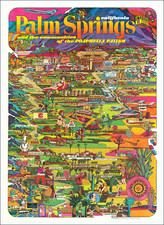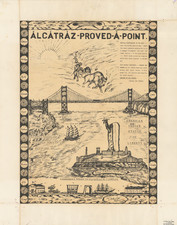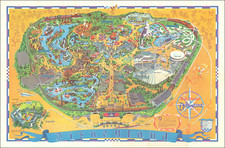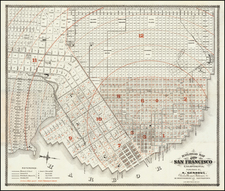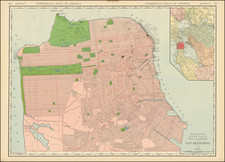The Castro - 1985
vibrant portrayal of San Francisco's Castro neighborhood at a time of great social activism but also at a moment when the LGBTQ+ community was being devastated by the AIDS epidemic. The map spotlights many of the establishments which catered to the gay community.
This vivid poster map of the Castro District in San Francisco offers an oblique perspective of one of the most iconic neighborhoods in the city, capturing its essence during a pivotal era in the late 20th century. The orthogonal grid of blue lines representing the main streets structures the view, creating spaces filled with dynamic and colorful imagery. The map focuses heavily on nightlife and community life, with scenes of people engaging in various activities, many centered on the gay community that has been the heart and soul of the Castro.
The figures depicted are a mix of detailed characters and more neutral, almost outline-like representations, adding a sense of universality and inclusiveness to the scenes. Local touches such as 49er football jerseys, California license plates, and hippies carrying ganja provide a strong San Francisco flavor. The presence of mustachioed men in cowboy hats, men hugging and dancing, and various other depictions of gay life reflect the unique culture and vibrancy of the Castro District. At the lower right is a portrait of Harvey Milk (1930-1978), who became a symbol of the Castro and wider LGBTQ+ community following his murder in 1978,
The Castro District
The Castro District, named after José Castro, a prominent Californio politician, became a symbol of LGBTQ+ activism and community life. Originating as Eureka Valley, the area was transformed in 1887 when the Market Street Railway Company linked it to downtown San Francisco.
Throughout the 20th century, the Castro evolved, particularly during the 1960s and 70s when it became a haven for the gay community. The neighborhood saw an influx of LGBTQ+ residents who revitalized the area, creating a vibrant and politically active community. This period was marked by significant events and figures, such as the rise of Harvey Milk, who opened a camera store in the Castro in 1973 and became a prominent gay rights activist.
The 1980s brought the devastating impact of the AIDS epidemic, profoundly affecting the community. Despite the hardship, the Castro remained a center of activism and support, leading efforts to combat the disease and promote safe practices. The map reflects this dual reality of celebration and struggle, capturing a community in the midst of both joy and pain.
Today, the Castro District remains a historic and cultural landmark, recognized for its contributions to LGBTQ+ history and its ongoing role as a symbol of diversity, resilience, and pride.
Rarity
The map is extremely rare.
We note a single example on the market and an example in the Library of Congress.










